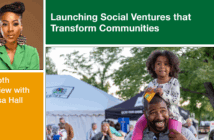Jessica L. Anschutz of the Lewis Center staff shares how congregations can begin to reach four groups of people through ministry on digital platforms.
As congregations continue to engage in ministry on digital platforms, we have a tremendous opportunity to witness to new groups of people. In Your Church Can Thrive, Harold Percy identifies four main groups of people that congregations can and should seek out: those who walk in, those in the pews, friends and family of current members, and those who live in the neighborhood. If we apply these four audiences to the digital realm, churches must seek out these groups: those who are observers, those engaged on digital platforms, friends and family of those engaged on digital platforms, and additional users of said platforms.
1. Those who are observers
Observers are those who watch or follow a congregation’s social media and digital ministry but are anonymous and not yet engaged. How can your congregation invite observers to connect more deeply? Consider how to be invitational so that those who are observing are invited to engage by sharing contact information, following, liking, subscribing, leaving a comment or a prayer request, etc. Equip pastors, staff, and/or volunteers to respond quickly to answer questions and help connect the observers to the right people and ministries. Sometimes all it takes for deeper engagement is a personal connection or a shared commitment to meet the needs of the community.
Share promotional videos to invite people to connect not only with the ministries of the congregation but with the people through a series of “meet our community” videos or social media posts. Host a virtual event for newcomers to learn about the community and meet some of the people who serve behind the scenes to support the ministries of the congregation.
2. Those engaged on digital platforms
Nurture people engaged on digital platforms so that they grow in faith and in relationship with one another and the rest of the congregation. Consider the many opportunities there are to support ministries without being present in person, then share those opportunities with the congregation. How can your congregation best connect those engaged on digital platforms to existing ministries, and how can existing ministries be expanded to digital platforms? Consider how to offer Bible studies, small group ministries, pastoral care, and/or children and youth ministry on digital platforms. Connect the recently engaged to the ministries that best suit their spiritual needs.
How are those who are engaged in ministry through digital platforms invited to participate in or support the mission activities of your congregation? Invite those who are engaged on digital platforms to engage more deeply in missions by praying for your mission ministries, providing financial support through direct financial support or by purchasing items on an Amazon wish list (or equivalent), volunteering for a similar ministry in their local community, or by volunteering to make phone calls to recruit volunteers or create social media posts to promote the ministry.
Consider how information about partner ministries such as Scouts, recovery groups, and other nonprofits is shared on your congregation’s digital platforms. How could connections with those groups and their social media platforms help the congregation to reach more people?
3. Friends and family
Sometimes those closest to us are those who are most likely to accept our invitations to join worship, small groups, or other ministries, yet all too often we fail to invite them. Rather than encouraging congregants to issue broad invitations with social media posts, encourage people to personally invite friends, family, and neighbors to digitally engage in the ministry that most closely aligns with their personal interests and spiritual needs. For example, invite a grieving neighbor to join a grief support group or a family with children to participate in your congregation’s family ministries.
With so much ministry happening on digital platforms, it is relatively easy for people to experience the ministries without walking through the doors of the church. Host a digital “ministry sampler” featuring rooms for Bible study, small group ministry, missions and more via Sidebar or other networking video chat platform. Invite observers and those engaged in your ministries. Encourage people to invite their friends and family to move from room to room to learn more about the congregation’s ministries and to meet some of their leaders.
Encourage your congregation to share, retweet, like, up vote, etc., posts about ministries so that people in their networks can learn about your congregation. Invite people to “check in” on social media as they participate in ministries and to share how others can participate.
4. Additional users of digital platforms
Advertise worship, special events, and ministries on digital platforms. Many social media platforms have quick and easy ways to set up ads and require only a small investment in order to reach a large number of people. Allocate funds in your congregation’s budget for advertising on digital platforms and experiment to see where the ads have the most impact. Then focus your efforts on those platforms. Keep in mind that different social media platforms appeal to various audiences, so promote relevant ministries on the appropriate platforms.
Make sure advertising on digital platforms is clear and concise. Refrain from using terms that could turn people away simply because they do not understand the insider terminology.
General tips for reaching people through digital ministry
- Promote your congregation’s ministries via digital platforms.
- Make sure up-to-date ministry information is readily available and promoted on all digital platforms.
- Use familiar words rather than religious terms to describe ministries and programs so that new people understand.
- Develop a plan for how your congregation will reach observers, those who are engaged on digital media, their friends and family, and users of social media; then implement the plan. Focus on those digital platforms where you have the highest levels of engagement, then work to build engagement on additional platforms. As technology and trends shift and change, adapt your plan for digital engagement.
- Provide easily accessible quick links to your congregation’s social media on all digital platforms. Consider using a service called a “link-in-bio” tool, such as Linktree, to put links to all your congregation’s digital content on a single page, making it easier for people to access.
- Invite active users of social media to help support your congregation’s presence on digital platforms.
Have fun, experiment, and strive to reach as many people as you can with the good news!
Related Resources
- Hybrid Evangelism: The New Reality for Congregations, a free video from the Lewis Center
- 4 Keys to Moving from Online Worship to Online Ministry by Nicole Reilley
- 4 Critical Areas of Support for Virtual Worship by Olu Brown






